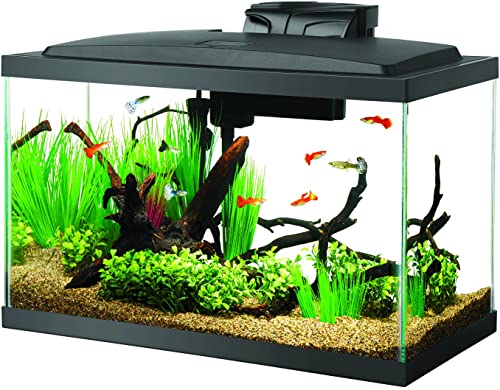
Fishkeeping is a very rewarding hobby. Adding a fish tank surely enhances the aesthetics of any place. Other than beautification, many health-related benefits are also associated with tank keeping. Observing an aquarium tank promotes a feeling of calmness and releases stress relieving hormones. Fish tanks are also known to help Alzheimer’s patients.
Many people wish to add a fish tank to their place but are intimidated by the process of setting up one. There is a general misconception that setting up an aquarium tank requires a lot of skills and expertise. Anyone who is passionate and dedicated can easily setup their own aquarium tank while following a series of a couple of simple steps.
The aim of this article is to provide a comprehensive guide regarding the process of setting up a fish tank. The process has been divided into simpler steps that are beginner friendly and easy to follow along. Here is what you need to do:
1. Planning:
The most common mistake that beginner’s tend to make when setting up their first fish tank is to jump straight towards execution. Before going ahead and collecting the material and equipment needed, it is important that you plan your tank.
- What type of tank do you wish to setup?
- Which size of the tank will be perfect for you?
- Do you wish to add different or one species of the fish to the tank?
- How many and which plants will you add to your tank?
- Where will the tank be placed?
These are a few questions and factors that one has to think about before proceeding with the tank setup. During this step, you will also be able to make a list of the items that you will need to setup your tank. Make sure that you purchase the accessories and the aquarium equipment from a reputable fish store like petfish.com.au.
When planning, it is often a good practice to draw a rough sketch of where your equipment and ornaments etc. will be placed inside the tank. This trick is especially suitable for those who wish to adapt to a certain aquarium tank style.
2. Preparing The Tank:
Now that you have a blueprint of the style and the type of the fish tank that you wish to set up, you can proceed with preparing your tank. People either purchase a new fish tank or opt for a used one. If you choose to buy a brand new fish tank, you will have to clean it with a damp cloth to get rid of any dust that may have been accumulated inside the tank. Make sure that you only use a damp cloth and avoid using soaps and harsh detergents for this purpose.
If you are using a used tank, the cleaning process will need to be a lot more rigorous and detailed. Clean the tank both from the inside as well as from the outside. Glass fish tanks are easier to clean and there is a lower risk of scratching the tank. However, when cleaning a fish tank made out of acrylics, use soft fiber clothes so you don’t add scratches to the surface of the tank.
3. Positioning And Placing The Tank:
Now comes the part where you will be placing the tank. The first step is to find a place where the tank will be housed. Make sure that you pick a spot that is away from direct sunlight. A power supply should also be within reach of the tank.
After selecting the location of the tank, you now need to find the surface on top of which the tank will be placed. The surface should be strong and sturdy. The tank may seem light right now but once the tank will be filled with water, its weight will increase significantly. The surface you choose to place your tank should be strong and flat.
Avoid filling the tank before setting it at the surface. The weight of the tank will increase so much that it will be hard to relocate. Therefore, place the tank first and then proceed to fill it up with water. When placing the tank, make sure that it is leveled against the surface. A tank that is not leveled properly is at a higher risk of toppling over.
4. Adding Water And Substrate:
Once the tank has been positioned properly, now you can go ahead and start adding substrate and water to your tank. There are a wide range of options of substrates that you can choose from. The type of substrate you choose to add to your tank depends on the type of the tank you wish to set up and the fish that you will be adding to the tank. The amount of the substrate to be added to the tank depends on the thickness of the substrate layer that you wish to have inside the tank.
After you have laid down the substrate, you can now set any ornaments, rocks and driftwood pieces etc. on the substrate. Make sure that the substrate has been thoroughly washed and cleaned before it is added to the tank. To prevent disturbing the substrate that has been laid down, you should place some bowl or saucer on top of the substrate and gradually add water to the tank.
5. Installation Of The Equipment:
After filling the tank with water, you can now move forward and set up the equipment. Even a basic aquarium tank does need a filter, lights and in some cases a CO2 system. The aquarium equipment comes with a comprehensive guide that helps you easily setup the equipment and use it properly once installed in the tank.
When choosing the equipment, make sure that you keep the requirements and needs of your tank in mind. The size and the number of fish that will be added to the tank are important factors that should be taken into consideration when choosing aquarium equipment.
Also make sure that you go through customer reviews and compare a couple of options rather than purchasing the first product you lay your eyes on. Another important thing is to ensure you choose a reliable pet store like petfish.com.au. This way, you will be a hundred percent sure that you will get your hands on high quality aquarium tank equipment.
6. Adding The Plants:
Now that everything else is done and taken care of, you can start adding plants to your newly set up tank. Having a look at the blueprint of the design and the set up of the tank that you initially laid down. Aquarium plants are sold when they have grown considerably. So all the tank owner needs to do when adding the plants to the tank is to gently remove the plant from the group and gently press the roots into the substrate of the tank.
It is important to rinse the plants and make sure that there is no dust on the surface of the plants. Skipping this step can lead to compromising the hygiene and overall cleanliness of the tank. The floating plants are the easiest to add to the tank. As indicated by the name, these plants remain floating inside the tank and do not require to be rooted inside the substrate of the tank.
7. Cycling The Tank:
Now that the setup is complete, beginner tank owners may get excited about adding the fish to the tank. But you are not there yet. To prepare the tank for the fish, it has to be cycled. The cycling or Nitrogen Cycling of the tank helps add nitrogen to the tank. This further promotes the growth of helpful bacteria that prevents algae bloom inside the tank.
Cycling the tank can require a couple of days. In case of a saltwater tank, one can also place a rock inside the tank which can become the source of the helpful bacteria. In case of a freshwater tank, you can easily purchase a bacterial culture or some ammonia that can be added to the tank to promote the growth of helpful bacteria that helps promote beneficial environment inside the tank that helps build a suitable home for the fish.
8. Adding The Fish:
The last step involved in the process of setting up an aquarium tank is adding fish. Make sure that you select fish that are compatible with one another. Fish that are not compatible with one another can cause chaos inside the tank. The fish should also be quarantined before they are added to the main tank. Give your fish some time to adjust to the new tank. Keep a close eye on the fish during the first couple of days and observe them to make sure they are comfortable and are doing well.
Follow these eight steps and you will be able to set up your tank without any issue. As a beginner, be prepared to make mistake and having to start over. But make sure that you don’t give up. Be persistent and you will surely be successful in setting up your tank within no time.







